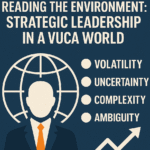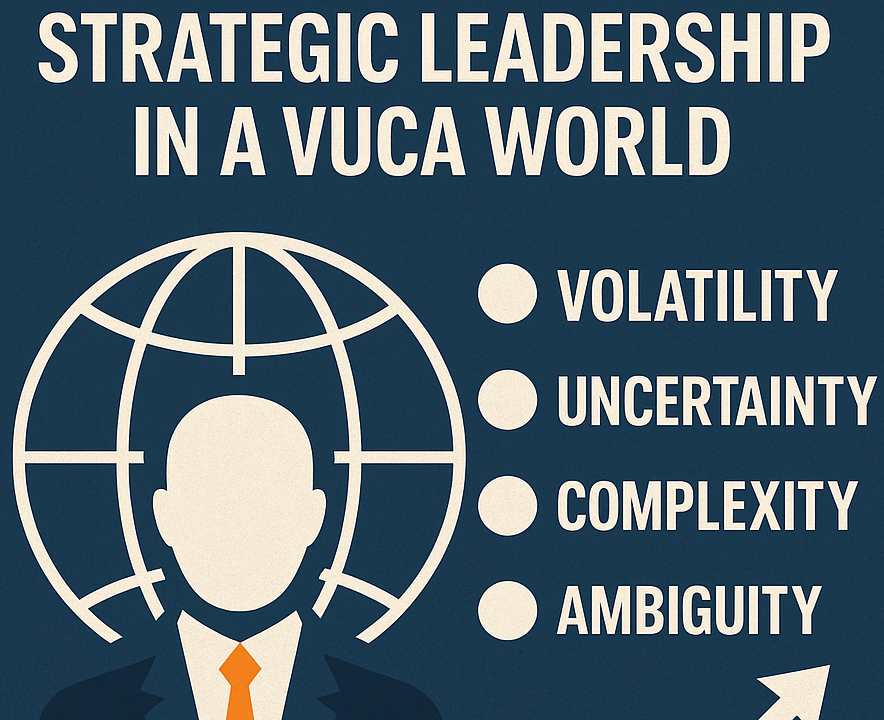
Reading the Environment: Strategic Leadership in a VUCA World
July 17, 2025
Strategic Leader Competencies: Building the Mindset and Skillset for Complex Challenges
July 20, 2025In today’s dynamic and complex organizational landscape, vision is more than a lofty aspiration, it is the cornerstone of effective strategic leadership. A well-crafted vision functions as a compass, guiding people, plans, and resources toward a shared and purposeful future. It provides clarity in uncertain environments and serves as an anchor for strategic alignment across diverse departments and stakeholder groups.
At its core, vision defines the desired future state of an organization. It acts as a guiding star, around which strategic leaders can shape operational methods (ways), identify strategic goals (ends), and allocate resources (means) accordingly (U.S. Army War College, 2010). In this way, vision is not only inspirational, but also actionable.
Strategic leaders must be intentional about vision at three interconnected levels:
- Organizational Vision: This is the broadest view, articulating the long-term direction of the entire enterprise.
- Departmental or Divisional Vision: These unit-level visions cascade from the organizational vision but are tailored to specific functions or areas of responsibility.
- Personal Vision: This reflects an individual’s internal compass, defining their purpose, core values, and professional aspirations. When aligned with broader organizational goals, personal vision enhances engagement and motivation at every level.
Understanding and articulating these three layers of vision adds connective tissue throughout the organization. It empowers even frontline team members to see how their daily contributions move the entire enterprise closer to its desired future. This emotional connection to purpose is critical, but it doesn’t exist in a vacuum. It depends heavily on the workplace climate that supports psychological safety.
Emotional Connection Requires Psychological Safety
For vision to truly inspire and align, people must feel safe enough to connect with it. As Amy Edmondson (2019) emphasizes in her research on psychological safety, individuals will not fully engage, intellectually or emotionally, if they fear judgment, exclusion, or punishment for voicing ideas or showing vulnerability. A compelling vision might spark initial interest, but without psychological safety, it fails to create the trust needed for ongoing dialogue, feedback, and alignment.
This means leaders must go beyond articulation of vision, they must cultivate the conditions that allow people to internalize it. In psychologically safe environments, team members are more likely to reflect on how their work contributes to the bigger picture, ask clarifying questions, challenge ideas constructively, and speak up when values are misaligned. These behaviors are essential not just for engagement but also for innovation and accountability, two pillars of strategic execution.
As Don Brecken (2004) noted, a well-crafted vision provides meaning, motivation, and a benchmark for excellence. But that only takes root when people feel safe enough to believe in it, contribute to it, and help shape its reality. Psychological safety, therefore, is not a soft skill, it’s a strategic imperative. Without it, emotional connection to vision becomes performative, inconsistent, or short-lived.
Vision as a Bridge to the Future
Moreover, vision serves as a bridge between the present and the future. It is both a catalyst and a strategic framework. As the U.S. Army War College (2010) notes, “Once a desired future state and resulting vision are developed, strategic leaders create a pathway to the future by means of strategy and plans” (p. 21). By using vision to anticipate emerging trends, leaders can adapt to change, maintain organizational relevance, and build resilient, forward-looking strategies.
In sum, vision is not just a slogan or motivational phrase, it is the heartbeat of strategy. But for vision to be alive in the hearts and minds of people, leaders must also cultivate psychological safety. When clearly articulated, deeply shared, and supported by a culture of trust, vision drives alignment, energizes teams, and enables leaders to transform ambition into meaningful and sustainable impact.
References
Brecken, D. (2004). Leadership vision and strategic direction. The Quality Management Forum, 30(1), 6–7.
Edmondson, A. C. (2019). The fearless organization: Creating psychological safety in the workplace for learning, innovation, and growth. Wiley.
U.S. Army War College. (2010). Strategic leadership primer (3rd ed., Chapter 2). Carlisle, PA: U.S. Army War College.


